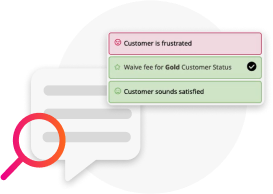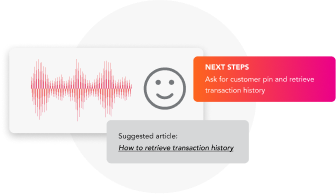Most people who become customer service professionals enjoy helping people. Yet, given the high levels of stress and complexity in today’s contact center, who’s helping the agents? After all, many agents are working from home these days, without coworkers and supervisors within earshot to ask questions or commiserate when customers are upset.
Traditional ways of helping agents get up to speed and coaching them on the job to improve their knowledge and call handling techniques are no longer effective in today’s contact center reality. Customer service agents must get up to speed quickly, stay up to date on constantly changing products and offers and solve increasingly complex customer issues on their own — all while juggling sustained high volumes of interactions.
The only way to empower agents and reduce their stress is to give them the assistance they need in the exact instant they need it — during the interaction with the customer. And this help must be available to all agents at the same time, no matter where they are working.
There’s only one solution that can do all this: real-time, in-call agent assistance. But which type of solution is better? Should you choose a rules-based tool or one that is powered by conversational artificial intelligence (AI)?
More Than One-Third of Agents Report Being Stressed All or Most of the Time

of agents report that they experience stress all or most of the time¹
of supervisors say they’re under near-constant stress¹
Disengaged Agents Are More Likely to Leave
Across contact centers and industries, agents are drowning in complexity as they manually navigate overflowing knowledgebases and written processes. In fact, agents, supervisors and management all report that inadequate and hard-to-use systems are one of the primary challenges to doing their jobs efficiently. Other top challenges includes the lack of customer information or context as well as inability to find the answer.1
Digging deeper, agents say that technology or processes are one of the top five stressors in their jobs. Existing systems and processes are also linked to the activities that agents report as the most time consuming: routine or mundane administrative tasks, routine or mundane customer interactions, and trying to find the answer or information.2
No wonder only one in three agents is engaged on the job, while the rest are likely to leave. Those who are disengaged are 84% more likely to look for a new job. Even those that report being neutral are 43% more likely to seek out a different job.3
Overall, teams with low engagement typically have turnover rates that are 18% to 43% higher than highly engaged teams.4 In 2022, every size contact center reported negative attrition rates greater than 30%.5
Agent Disengagement Affects Customer Effort and Experience
Disengaged agents are three times more likely to engage in behaviors that prolong interactions and negatively impact customer outcomes:


greater frequency of failing to deliver first contact resolution³
more likely to ask customers to repeat information³
less likely to reduce the number of steps toward resolution³
Agents Need Assistance in the Moment
The only way to transform the agent (and the customer) experience is by giving agents the guidance and coaching they need at the precise moment they need it — while they are helping resolve customer issues. Human coaches can’t possibly provide the depth and scale needed to achieve this level of direct assistance in every conversation. Instead, it requires technology specifically developed for real-time, in-call agent assistance.
With in-call agent assistance, agents can resolve issues faster, demonstrate empathy, focus on the conversation and be more productive. A comprehensive solution can augment and assist agents during the call, either with rules-based guidance and workflows, conversational AI to provide personalized, dynamic guidance based on the conversation, or a combination of both.
How do you choose between rules-based or conversational AI-powered guidance? It all depends on the needs of your business. For example, rules-based in-call agent assistance offers a rapid time to value, is language agnostic, helps accelerate agent proficiency, reduces errors, and ensures consistency and compliance across every call.
AI-powered in-call assistance lets you personalize guidance for each call, improves the customer experience, reduces agent discovery time, and scales to support more customer intents than rules-based solutions.
When to Use Rules-Based Assistance
Sometimes companies choose to start with a rules-based automation solution because they want to being achieving results as quickly as possible. Then they build on their success by expanding automation and introducing conversational AI to further optimize the customer and agent experience.
When looking for a rules-based solution, choose one that makes it easy to pre-program real-time agent guidance to help new agents onboard more quickly and existing agents keep pace with changes. By providing proactive and predictive help in the form of scripts, embedded processes, guided workflows, and next best actions, pre-programmed guidance helps agents resolve issues faster, reduces onboarding time and ensures consistency across calls as well as adherence to business rules and requirements.
Rules-based solutions can also take advantage of robotic desktop automation to automate manual tasks, saving agents time, preventing errors and freeing up agents to focus on the conversation with the customer. Automating tasks such as updating customer relationship management (CRM) systems and sending follow-up emails to customers reduces the stress and anxiety that comes from agents rushing through manual workflows and tasks as they work to identify and resolve the customer’s issue.
When to Choose Conversational AI to Personalize the Experience
Conversational AI brings the incredible power of machines to augment and assist agents during the interaction, delivering contextual and personalized guidance specific to the conversation and the customer. Automation based on conversational AI lets you scale to cover more customer intents as well as multiple intents during one interaction.
AI-powered real-time agent assistance listens to and understands every conversation, delivering personalized guidance based on context that helps agents resolve issues even faster, demonstrate empathy and understanding, focus on the conversation and improve performance. A real-time agent assistance solution powered by conversational AI can:


Analyze customer context including sentiment, emotion and intent to provide personalized guidance based on the conversation


Identify new intents during the conversation to help agents understand and better serve customer needs


Identify patterns and changes to them to alert agents in real time about products and services that would be most relevant
Engaged and Happy Agents Mean Happier Customers
Whether you automate agent tasks and assistance using rules and pre-designed workflows or you apply conversational AI, investing in real-time agent assistance significantly improves the agent experience and helps reduce attrition.
By empowering their agents with guidance and automation at the right moment — throughout the customer conversation — contact centers are reporting remarkable results, including:
50%
reduction in agent onboarding time
40%
lower average handling times
20%
improvement in first contact resolution
Happier agents also make for happier customers, helping your contact center reach your goals for the metrics that matter most, such as customer satisfaction and Net Promoter Score.
Sources
- “The Post-Pandemic Agent Experience: What’s Changed and What Needs to Change?” ICMI, 2022
- Ibid.
- “Gartner Says Only One in Three Customer Service Reps Are Engaged on the Job,” Gartner, June 2021
- “The ‘Great Resignation’ Is Really the ‘Great Discontent,” Vipula Gandhi and Jennifer Robison, Gal lup, July 2021
To learn more about prioritizing the agent expereince with real time in-call agent assistance, read the buyer's guide
